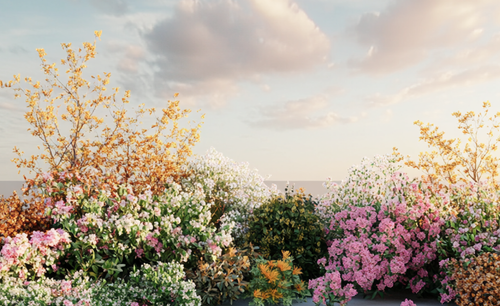San Francisco is famous for its fog, but that’s only part of the story. Walk a few blocks or drive over a hill, and you might find yourself in a completely different temperature zone. This patchwork of shifting weather conditions is the result of the city’s microclimates—a unique environmental phenomenon shaped by topography, ocean influence, and other regional factors.
Understanding San Francisco’s microclimates isn’t just interesting—it’s practical. It can help you choose what to wear, where to live, how to design your garden, and even how to build or invest in property.
1. What Are Microclimates?
Microclimates are localized weather systems that differ from the broader surrounding climate. In San Francisco, you can experience a 20-degree temperature swing within just a few miles. For instance, on a summer day, it might be 85°F in the Mission District, while the Outer Sunset sits under fog at 60°F.
It’s not just temperature—rainfall varies significantly too. According to National Weather Service data:
- The Sunset District receives around 25 inches of annual rainfall
- The Mission District often gets closer to 18 inches
- Twin Peaks, acting as a fog catchment and windbreak, receives even more, sometimes over 30 inches annually
This dramatic range of microclimates is rare in such a compact urban area and has made San Francisco a case study in urban climate variability.
2. What Influences San Francisco’s Microclimates?
San Francisco’s weather puzzle is pieced together by several interrelated factors:
Topography
The city’s 48 hills create natural barriers and wind channels that redirect air flow, causing fog and cool marine air to settle in lower elevations or coastal districts while sunnier, warmer air gets trapped in others.
Proximity to Water
The Pacific Ocean to the west and San Francisco Bay to the east act as natural air conditioners, keeping nearby areas cooler and more humid. Neighborhoods closer to the coast (like the Richmond and Sunset) tend to be foggier and cooler, while areas further inland are warmer and drier.
Wind Patterns
The prevailing west winds, especially in summer, push cool ocean air through gaps in the coastal mountains—primarily through the Golden Gate, creating the city’s signature fog.
Elevation
Neighborhoods like Twin Peaks, which sit at higher elevations, experience rapid changes in temperature and fog density. Elevation also determines how much direct sunlight an area receives.
Urban Heat Island Effect
Densely built-up areas with more pavement and less vegetation retain heat, making neighborhoods like SoMa and Financial District slightly warmer, especially during sunny afternoons.
3. A Look at San Francisco's Microclimate Zones
Rather than just isolated examples, here are the primary microclimate zones that define the city:
1. Coastal Fog Belt
- Neighborhoods: Outer Sunset, Outer Richmond, Ocean Beach
- Conditions: Cool, foggy, windy, and overcast
- Notes: Consistently chilly even in summer; heavy marine layer
2. Central Fog Transition Zone
- Neighborhoods: Inner Sunset, Inner Richmond, Golden Gate Park
- Conditions: Mix of foggy mornings and clearer afternoons
- Notes: Transition zone between coastal and sunnier neighborhoods
3. Sunny Interior Valleys
- Neighborhoods: Mission District, Potrero Hill, Noe Valley
- Conditions: Warm, dry, and sunny
- Notes: Sheltered from ocean air by hills; among the warmest zones in SF
4. Windy Ridge Lines
- Neighborhoods: Twin Peaks, Diamond Heights, Bernal Heights
- Conditions: Windy with rapid temperature shifts
- Notes: Higher elevation, variable visibility, weather barrier
5. Bay-Influenced Microclimate
- Neighborhoods: Financial District, Embarcadero, North Beach
- Conditions: Moderate humidity, cooler breezes, mild temps
- Notes: Influenced by SF Bay rather than the ocean
4. Why Microclimates Matter (Especially for Gardeners)
San Francisco's microclimates aren’t just a fun fact—they dramatically impact daily life, especially when it comes to gardening, landscaping, and outdoor planning.
🌿 Gardening and Landscaping
This is where microclimates play a huge role. Planting choices that work in Noe Valley may struggle in Outer Sunset. Understanding the conditions of your microclimate can mean the difference between a thriving garden and a costly mistake.
Key Considerations for Gardeners:
- Sunlight Exposure:
- Coastal areas often get 2-4 fewer hours of sun per day compared to sunnier districts like the Mission.
- Use shade-tolerant plants (like ferns or hydrangeas) in foggy zones and sun-loving species (like lavender or rosemary) in warmer microclimates.
- Soil Moisture and Drainage:
- Fog-heavy neighborhoods tend to retain more moisture; choose plants that don’t require frequent watering.
- In sunny zones, consider drought-tolerant native plants like California poppies, manzanita, or ceanothus.
- Wind Exposure:
- Areas like Twin Peaks may need windbreaks or protective fencing for delicate plants.
- Use low-profile shrubs and grasses in high-wind areas.
- Pest Pressure & Salt Tolerance:
- Near the coast, choose salt-tolerant plants and be mindful of the impact of coastal wind on foliage.
- Design Tip:
- Use plant layering: low groundcovers + medium shrubs + taller focal plants to create shelter and visual balance.
🌱 Resources for SF Gardeners:
- San Francisco Botanical Garden – Offers plant guides and local workshops.
- Friends of the Urban Forest – Supports sidewalk garden projects and tree planting by microclimate.
- PlantSF – Provides support for replacing pavement with gardens, including permit help.
5. Real Estate, Lifestyle, and Wardrobe Planning
San Francisco’s microclimates can impact where people choose to live. For example, people who value sun and warmth may gravitate toward Potrero Hill or Noe Valley, while others prefer the cool, quiet fog of West Portal or the Sunset.
- Real Estate: Homes in sunnier neighborhoods can fetch 10–15% more than similarly sized homes in foggier zones, all other things being equal.
- Commute Planning: Microclimates can also influence commuting preferences—walking in fog vs. biking in the sun.
- Clothing Choices: The classic advice still holds—always dress in layers in San Francisco.
Microclimates as a Feature, Not a Flaw
San Francisco’s microclimates can feel chaotic at first—but they also make the city uniquely dynamic and full of character. From the fog rolling in over Sutro Tower to the sunny patios in the Mission, the weather becomes part of your neighborhood’s personality.
Understanding your microclimate helps you make better choices—whether you're planting a garden, buying a home, or just deciding whether to pack a jacket.






